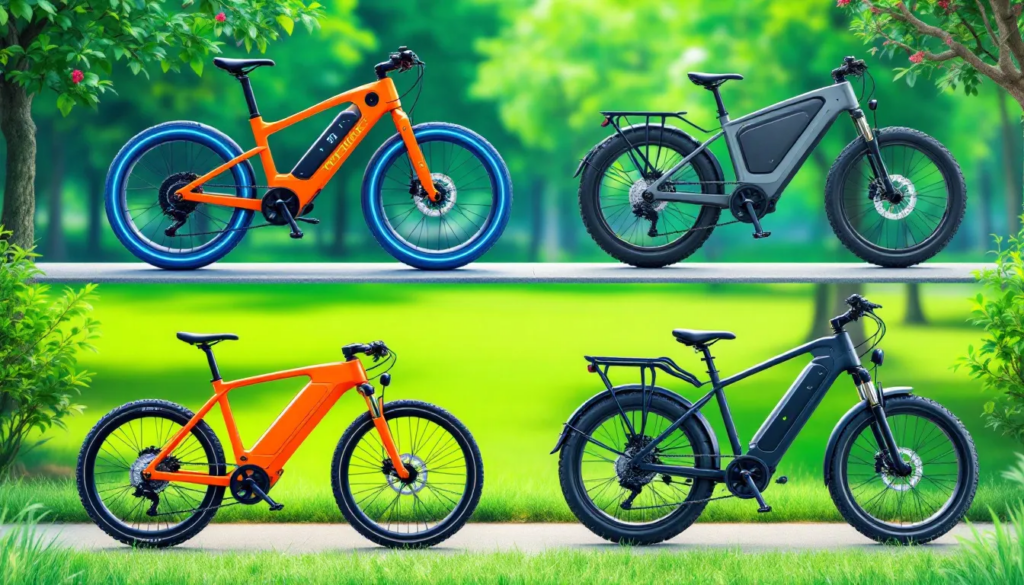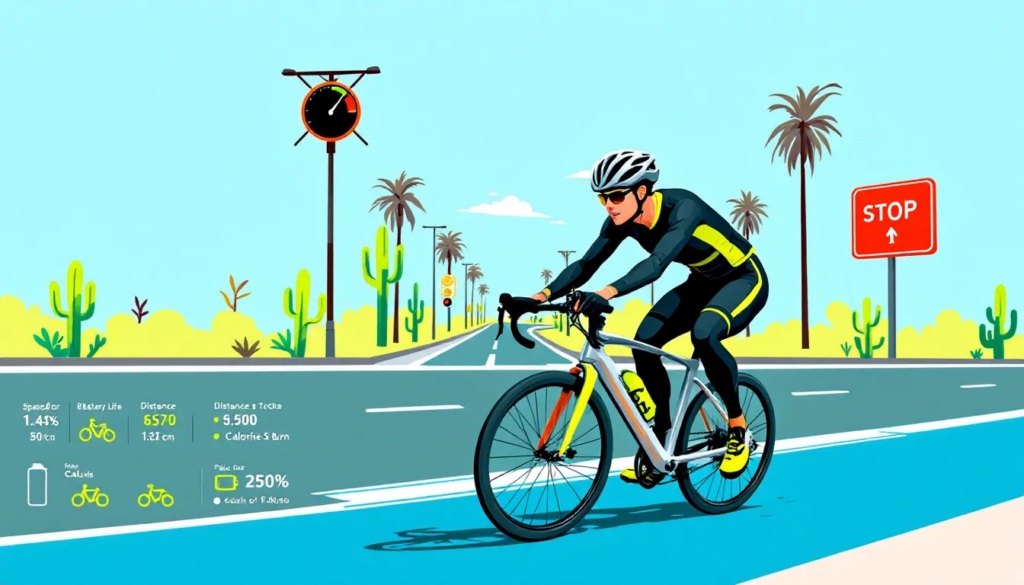Understanding Texas e-bike laws is crucial for staying safe and legal on the road. This guide breaks down the different e-bike classes, key riding regulations, and local rules to ensure you’re fully informed.
Key Takeaways
Texas law classifies e-bikes into three categories: Class 1 (pedal-assist up to 20 mph), Class 2 (throttle-assisted up to 20 mph), and Class 3 (pedal-assist up to 28 mph, with age restrictions).
E-bike riders must adhere to traffic laws similar to traditional bicycles, including local regulations, helmet laws for those under 18, and speed limits based on the path or lane.
E-bikes offer significant environmental, health, and economic benefits, including lower emissions, improved fitness, and reduced commuting costs, contributing to their increasing popularity and evolving legislation in Texas.
Understanding E-Bike Classes in Texas

Texas law defines electric bicycles into three distinct categories based on their speed and motor assistance. Knowing these classes helps you comply with Texas electric bike laws and promotes a safe riding experience. Each class has specific attributes that determine where and how you can ride these e-bikes.
Class 1 e-bikes provide pedal-assist up to 20 miles per hour, while Class 2 e-bikes, on the other hand, come equipped with a throttle that allows them to reach speeds of up to 20 miles per hour without pedaling. Lastly, Class 3 e-bikes offer pedal-assist up to 28 miles per hour but require riders to be at least 16 years old, showcasing the benefits of assisted speed.
This classification system regulates e-bike use, ensuring compliance with the Texas transportation code without requiring a license, registration, or insurance.
Class 1 E-Bikes
Class 1 e-bikes are a popular choice among e-bike riders due to their simplicity and ease of use. These electric bicycles provide pedal-assist up to 20 miles per hour and are equipped with fully operable pedals, making them ideal for riding on bike lanes and bike paths.
Class 1 e-bikes have no age restrictions in Texas, making them accessible to everyone from young teens to older adults. Combining the benefits of an electric motor with the feel of a regular bike, they are versatile for various riding conditions, including non-motorized trails and motorized vehicle zones where allowed.
Class 2 E-Bikes
Class 2 e-bikes stand out for their throttle feature, allowing riders to reach speeds of up to 20 miles per hour without the need to pedal. This feature is convenient for those who want a break from pedaling or prefer a more relaxed ride.
They also have fully operable pedals, allowing riders to use pedal assist if desired. Similar to Class 1, Class 2 e-bikes have no age restrictions in Texas, making them accessible to a wide range of riders.
Class 3 E-Bikes
Class 3 e-bikes offer a more robust riding experience with their ability to provide pedal-assist up to 28 miles per hour. However, Texas regulations require riders to be at least 16 years old due to the higher speeds of Class 3 e-bikes.
These electric bikes are ideal for those looking for a faster commute or a more vigorous workout, but it’s important to remember that they come with additional responsibilities and restrictions compared to Class 1 and Class 2 e-bikes.
Key Regulations for Riding E-Bikes in Texas

Riding e-bikes in Texas comes with a set of regulations that ensure the safety of both the rider and the public. According to the Texas transportation code, e-bikes are classified as bicycles, which means they must adhere to the same traffic laws as traditional bicycles. This means following local traffic rules, which can vary depending on the area. Additionally, e-bike riders must be aware of DUI laws, as these apply to e-bike riders on public roads just as they do to car drivers.
Modifying an e-bike to exceed its legal speed limits can lead to it being reclassified as a motor vehicle, which would require licensing, registration, and insurance. Understanding and complying with the specific regulations for each e-bike class helps avoid legal issues.
Always check local authority guidelines, as additional rules may apply in different areas.
Helmet Laws
Helmet laws in Texas are especially important for younger e-bike riders. It is mandatory for anyone under the age of 18 to wear a helmet while riding an e-bike. This requirement is even more stringent for Class 3 e-bikes, where riders must wear a helmet if they are under 18 and meet the minimum age requirement of 16 to operate the bike.
Although helmets are not mandatory for riders over 18, they are highly recommended for safety.
Speed Limits
Adhering to speed limits is essential for safe and legal e-bike riding. Class 2 e-bikes, for example, must have their motor shut off at 20 miles per hour. All e-bikes should adhere to the speed limits established for the paths they use.
If riding on a path or lane with a lower speed limit, you must comply regardless of your e-bike’s capabilities. Following speed limits ensures the safety of all trail and road users.
Bike Lanes and Paths
E-bikes are generally allowed on bike lanes, multi-use paths, and roads with speed limits up to 35 mph. On shared paths, e-bike riders should reduce speed around pedestrians and announce their presence when overtaking. Yielding to pedestrians and respecting other users’ space maintains safety and harmony on shared trails.
Keeping noise levels down is courteous and preserves the natural experience for all trail users.
Local Authority Regulations
Local authorities in Texas have the power to enforce additional regulations on e-bike usage. While cities cannot restrict e-bikes in places where bicycles are allowed, they can implement specific rules that may vary from state laws. This flexibility allows municipalities to address the unique needs and concerns of their communities, ensuring that e-bike use is safe and harmonious with other forms of transportation.
Knowing local regulations is important for e-bike riders, as rules can vary significantly from city to city. Check local ordinances and rules for the areas you plan to ride to avoid legal issues and ensure compliance.
City-Specific Rules
City-specific rules can vary widely across Texas. For instance, in Austin, e-bikes are allowed on all bike lanes and paths, making it a bike-friendly city for e-bike riders. Conversely, Houston has specific limits on where e-bikes can be ridden.
Additionally, municipalities may impose their own helmet laws, particularly for minors. Checking your city’s local rules ensures a smooth and legal riding experience.
State Parks and Trails
When it comes to state parks and trails, e-biking can offer a wonderful way to explore the natural beauty of Texas. However, regulations can vary by park. Certain Texas state parks allow specific e-bikes on designated trails, while others have restrictions, particularly regarding Class 3 e-bikes.
Always check local rules before using a trail with an e-bike, as access can vary by park. Engaging with local land managers or advocacy groups can help influence policy changes to improve e-bike access.
Safety Guidelines for E-Biking in Texas

Safety should be a top priority for e-bike riders. Regular use of e-bikes can improve cardiovascular health through increased physical activity. E-bikes also contribute to enhanced mental well-being by reducing stress and increasing outdoor exposure. Ensuring safety involves more than just riding; it requires proper preparation and following safety guidelines.
Pre-ride checks, on-road safety, and trail etiquette are essential for a safe and enjoyable e-biking experience. These practices not only protect the rider but also ensure the safety and comfort of others sharing the road or trail.
Pre-Ride Checks
Before heading out, inspect the e-bike’s battery condition and tire pressure. Checking tire pressure and condition prevents maintenance issues and enhances safety and performance.
Thorough pre-ride checks, such as ensuring functioning brakes and adequate pad material, help ensure a smoother and safer ride.
On-Road Safety
On-road safety is crucial for e-bike riders. Wearing reflective clothing and using lights during nighttime rides significantly enhances visibility. E-bike riders must obey traffic laws, including stopping at stop signs and traffic signals, just like traditional cyclists.
High visibility, especially at night, is crucial to avoid accidents and ensure a safe journey.
Trail Etiquette
Good trail etiquette is crucial for maintaining harmony among various recreational users. Here are some key points to remember:
Announce your presence in advance when approaching other trail users.
Yield to those going uphill.
Signal your intention to pass and do so at a safe distance to avoid startling others.
Stay to the right side of the trail to allow space for others to pass on the left.
By following these guidelines, you can help ensure a positive experience for everyone on the trail.
Remember, respecting natural areas and wildlife contributes to the sustainability of these beautiful spaces.
Benefits of E-Bikes

E-bikes offer numerous benefits beyond just transportation. Environmentally, they significantly lower greenhouse gas emissions compared to gasoline-powered vehicles. They help decrease traffic congestion in urban areas by replacing short car trips, making them a sustainable option.
Regular use of e-bikes enhances cardiovascular fitness and improves mental well-being by connecting users with their surroundings and outdoor experiences.
Economically, e-bikes can significantly reduce commuting costs compared to car ownership. E-bikes generally have lower maintenance costs than traditional motor vehicles and are often eligible for incentive programs, further reducing their overall cost.
E-bikes equipped with a motor present an attractive and practical solution for various transportation and recreational needs.
Environmental Impact
E-biking is a fun and efficient way to get around with significant environmental benefits. E-bikes significantly lower greenhouse gas emissions compared to traditional vehicles, contributing to cleaner air and reduced pollution levels. By replacing short car trips, e-bikes reduce traffic congestion in urban areas.
E-bikes are a sustainable transportation option that supports cleaner air and less congested roads.
Health Benefits
E-bikes provide substantial health benefits, making them an excellent choice for improving physical fitness while enjoying the outdoors. Regular e-bike use enhances cardiovascular fitness by providing aerobic exercise without the strain of traditional cycling. They also improve muscle strength and endurance, allowing riders to benefit from cycling even with mobility issues.
Riding an e-bike can significantly reduce stress and anxiety, offering a sense of freedom and relaxation.
Economic Advantages
The economic advantages of owning an e-bike are significant. E-bikes can reduce commuting costs significantly compared to expenses associated with car ownership. Savings on fuel, maintenance, and parking can be substantial since e-bikes typically have lower maintenance costs than traditional motor vehicles.
Additionally, many e-bikes qualify for incentive programs, further reducing their overall cost. These economic benefits make e-bikes a cost-effective and practical transportation choice.
Future of E-Bike Legislation in Texas

E-bike legislation in Texas is evolving, with lawmakers continually reviewing and proposing new bills to address their growing popularity. Future legislative discussions may aim to create more inclusive e-bike regulations that accommodate all stakeholders, including considerations of Texas laws. This could lead to changes in e-bike regulations, potentially expanding access and clarifying existing rules.
Advocacy efforts are crucial in shaping these future laws. Advocacy groups are actively pushing for clearer e-bike legislation to ensure fair treatment of cyclists. By engaging with community members and lawmakers, these groups help shape effective e-bike policies that promote rider rights and safety.
Collaboration between advocacy groups and legislators is vital for crafting mutually agreeable bills that benefit all parties involved.
Proposed Bills
Several proposed bills under review could change current e-bike access rules in Texas. One notable example is HB 715, which faced opposition and was pulled from consideration due to its restrictive language on e-bike use in state parks.
Substitute language was offered to address the bill’s troubling aspects, reflecting ongoing efforts to create balanced regulations. As the legislative session ends, HB 715 is likely to remain in committee, but a special legislative session may further discuss e-bike regulations.
Advocacy Efforts
Advocacy groups are crucial in shaping e-bike policies and promoting rider rights. These groups work tirelessly to push for clearer e-bike legislation and ensure fair treatment for cyclists under the law. By engaging with community members and lawmakers, advocacy groups help create effective and inclusive e-bike policies.
Their efforts are instrumental in driving legislative changes that benefit the growing community of e-bike riders and e bike in Texas.
Summary
In summary, understanding and adhering to Texas e-bike laws is essential for a safe and enjoyable riding experience. The state classifies e-bikes into three distinct categories, each with specific regulations regarding speed limits, helmet requirements, and allowable riding paths. Local authorities may impose additional rules, so it’s crucial to stay informed about the regulations in your area.
The benefits of e-bikes extend beyond just transportation. They offer significant environmental, health, and economic advantages, making them an attractive option for many Texans. As e-bike legislation continues to evolve, staying engaged with advocacy efforts and legislative updates will help ensure that e-bike riders are well-represented and that future laws support the safe and equitable use of e-bikes. Ride safely, stay informed, and enjoy the many benefits that e-biking in Texas has to offer.
Frequently Asked Questions
Where can you ride an eBike in Texas?
You can ride an eBike in Texas on popular trails such as the San Antonio River Walk Hike & Bike Path, Ann and Roy Butler Hike and Bike Trail, and Campion Trail. These scenic routes provide excellent options for enjoying your eBike adventure.
Are e-bikes street legal in Texas?
E-bikes are street legal in Texas and can be ridden on all roadways, as well as bike paths and trails unless otherwise indicated. However, riders must stay to the right except when making a left turn.
What are the different classes of e-bikes in Texas?
Texas classifies e-bikes into three categories: Class 1 provides pedal-assist up to 20 mph, Class 2 allows for 20 mph with throttle power alone, and Class 3 offers pedal-assist up to 28 mph but mandates that riders be at least 16 years old. Understanding these classifications is crucial for compliance and safe riding.
Are helmets required for e-bike riders in Texas?
Helmets are mandatory for e-bike riders under 18 years old in Texas, particularly for those on Class 3 e-bikes, while there are no helmet requirements for those 18 and older.
Can e-bikes be ridden on bike lanes and paths in Texas?
Yes, e-bikes can be ridden on bike lanes and multi-use paths in Texas, provided that riders are mindful of their speed, especially near pedestrians. Always ensure to follow local regulations for safe riding.


